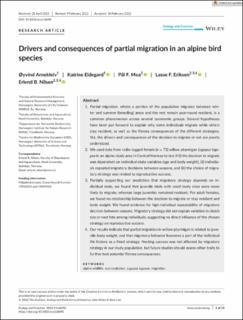| dc.description.abstract | 1. Partial migration, where a portion of the population migrates between win-ter and summer (breeding) areas and the rest remain year- round resident, is a common phenomenon across several taxonomic groups. Several hypotheses have been put forward to explain why some individuals migrate while others stay resident, as well as the fitness consequences of the different strategies. Yet, the drivers and consequences of the decision to migrate or not are poorly understood.2. We used data from radio- tagged female (n= 73) willow ptarmiganLagopus lago-pus in an alpine study area in Central Norway to test if (i) the decision to migrate was dependent on individual state variables (age and body weight), (ii) individu-als repeated migratory decisions between seasons, and (iii) the choice of migra-tory strategy was related to reproductive success.3. Partially supporting our prediction that migratory strategy depends on in-dividual state, we found that juvenile birds with small body sizes were more likely to migrate, whereas large juveniles remained resident. For adult females, we found no relationship between the decision to migrate or stay resident and body weight. We found evidence for high individual repeatability of migratory decision between seasons. Migratory strategy did not explain variation in clutch size or nest fate among individuals, suggesting no direct influence of the chosen strategy on reproductive success.4. Our results indicate that partial migration in willow ptarmigan is related to juve-nile body weight, and that migratory behavior becomes a part of the individual life history as a fixed strategy. Nesting success was not affected by migratory strategy in our study population, but future studies should assess other traits to further test potential fitness consequences. alpine wildlife, eco-evolution, Lagopus lagopus, migration | |
